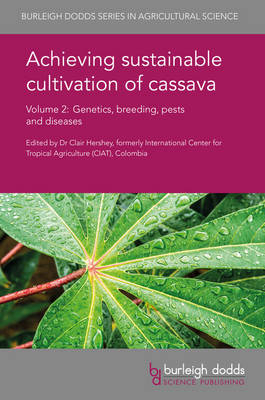
Achieving Sustainable Cultivation of Cassava Volume 2
Burleigh Dodds Science Publishing Limited (Verlag)
978-1-78676-004-3 (ISBN)
Originating in South America, cassava is grown in over 100 countries around the world. It is the third most important source of calories in the tropics after rice and maize. Its caloric value, as well as its ability to tolerate dry conditions and poor soils, makes it a key food security crop in developing countries. As demand for food grows, there is an urgent need to increase yields in the face of such challenges as climate change, threats from pests and diseases and the need to make cultivation more resource-efficient and sustainable.
Drawing on an international range of expertise, this collection focuses on ways of improving the cultivation of cassava at each step in the value chain, from breeding to post-harvest storage. Volume 2 starts by reviewing genetic resources, advances in breeding and their application to produce varieties with desirable traits such as higher yield. It then goes on to review developments in understanding and managing pests and diseases.
Achieving sustainable cultivation of cassava Volume 2: Genetic resources, breeding, pests and diseases will be a standard reference for agricultural scientists in universities, government and other research centres and companies involved in improving cassava cultivation. It is accompanied by Volume 1 which reviews cultivation techniques.
Dr Clair Hershey is former Cassava Program Leader at the world-famous International Center for Tropical Agriculture (CIAT) in Colombia. With a background in plant breeding, Dr Hershey has previously worked for the FAO and the Global Partnership Initiative for Plant Breeding Capacity Building (GIPB) and was Editor of Plant Breeding News.
Part 1 Cassava genetic resources and breeding tools
1.Advances in understanding cassava growth and development: Virgílio Gavicho Uarrota, Deivid L. V. Stefen, Clovis Arruda de Souza (UTM) and Cileide Maria Medeiros Coelho, University of the State of Santa Catarina (UDESC), Brazil; Rodolfo Moresco and Marcelo Maraschin, Federal University of Santa Catarina (UFSC), Brazil; Fernando David Sánchez-Mora, Technical University of Manabí, Ecuador; and Eduardo da Costa Nunes, Enilto de Oliveira Neubert and Luiz Augusto Martins Peruch, Santa Catarina State Agricultural Research and Rural Extension Agency (EPAGRI), Brazil;
2.Conservation and distribution of cassava genetic resources: Michael Abberton, Badara Gueye, Tchamba Marimagne and Folarin Soyode,
International Institute of Tropical Agriculture (IITA), Nigeria;
3.Developing new cassava varieties: tools, techniques and strategies: Hernán Ceballos, Nelson Morante, Fernando Calle, Jorge Lenis and Sandra Salazar, International Center for Tropical Agriculture (CIAT), Colombia;
4.Molecular approaches in cassava breeding: Luis Augusto Becerra Lopez-Lavalle, International Center for Tropical Agriculture (CIAT), Colombia;
5.Marker-assisted selection in cassava breeding: Ismail Y. Rabbi, International Institute of Tropical Agriculture (IITA), Nigeria;
6.Advances in genetic modification of cassava: P. Zhang, Q. Ma, M. Naconsie, X. Wu, W. Zhou, National Key Laboratory of Plant Molecular Genetics, CAS Center for Excellence in Molecular Plant Sciences, Chinese Academy of Sciences, China and J. Yang, Shanghai Chenshan Plant Science Research Center, Shanghai Chenshan Botanical Garden, China;
Part 2 Breeding improved cassava varieties
7.Breeding cassava for higher yield: Piya Kittipadakul, Pasajee Kongsil and Chalermpol Phumichai, Kasetsart University,
Thailand; and Shelley H. Jansky, USDA-ARS Vegetable Crops Research Unit and University of Wisconsin-Madison, USA;
8.Breeding, delivery, use and benefi ts of bio-fortifi ed cassava: Elizabeth Parkes and Olufemi Aina, International Institute of Tropical Agriculture (IITA), Nigeria;
9.Breeding cassava to meet consumer preferences for product quality: Adebayo Abass, International Institute of Tropical Agriculture (IITA), Tanzania; Wasiu Awoyale, International Institute of Tropical Agriculture (IITA), Liberia and Kwara State University, Nigeria; and Lateef Sanni and Taofi k Shittu, Federal University of Agriculture, Nigeria;
Part 3 Managing pests and diseases
10.Diseases affecting cassava: James Legg, International Institute of Tropical Agriculture (IITA), Tanzania; and
Elizabeth Alvarez, International Center for Tropical Agriculture (CIAT), Colombia;
11.Integrated management of arthropod pests of cassava: the case of Southeast Asia: Ignazio Graziosi and Kris A.G. Wyckhuys, International Center for Tropical Agriculture (CIAT), Vietnam;
12.Weed control in cassava cropping systems: S. Hauser and F. Ekeleme, International Institute of Tropical Agriculture (IITA), Nigeria;
| Erscheinungsdatum | 01.02.2018 |
|---|---|
| Reihe/Serie | Burleigh Dodds Series in Agricultural Science ; 21 |
| Co-Autor | Dr Virgilio Gavicho Uarrota, Deivid L. V. Stefen, Clovis Arruda de Souza, Cileide Maria Medeiros Coelho |
| Zusatzinfo | Colour tables, photos and figures |
| Verlagsort | Cambridge |
| Sprache | englisch |
| Maße | 152 x 229 mm |
| Themenwelt | Naturwissenschaften ► Biologie ► Botanik |
| Naturwissenschaften ► Biologie ► Ökologie / Naturschutz | |
| Weitere Fachgebiete ► Land- / Forstwirtschaft / Fischerei | |
| ISBN-10 | 1-78676-004-5 / 1786760045 |
| ISBN-13 | 978-1-78676-004-3 / 9781786760043 |
| Zustand | Neuware |
| Haben Sie eine Frage zum Produkt? |
aus dem Bereich


